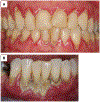The dental plaque biofilm matrix
- PMID: 33690911
- PMCID: PMC9413593
- DOI: 10.1111/prd.12361
The dental plaque biofilm matrix
Abstract
The extracellular matrix is a critical component of microbial biofilms, such as dental plaque, maintaining the spatial arrangement of cells and coordinating cellular functions throughout the structure. The extracellular polymeric substances that comprise the matrix include carbohydrates, nucleic acids, proteins, and lipids, which are frequently organized into macromolecular complexes and/or are associated with the surfaces of microbial cells within the biofilm. Cariogenic dental plaque is rich in glucan and fructan polysaccharides derived from extracellular microbial metabolism of dietary sucrose. By contrast, the matrix of subgingival dental plaque is a complex mixture of macromolecules that is still not well understood. Components of the matrix escape from microbial cells during lysis by active secretion or through the shedding of vesicles and serve to anchor microbial cells to the tooth surface. By maintaining the biofilm in close association with host tissues, the matrix facilitates interactions between microorganisms and the host. The outcome of these interactions may be the maintenance of health or the development of dental disease, such as caries or periodontitis. The matrix affords microbial cells protection against chemical and physical insults and hinders the eradication of pathogenic dental plaque. Therefore, strategies to control the matrix are critical to maintain oral health. This review discusses recent advances in our understanding of the composition, origins, and function of the dental plaque matrix, with a focus on subgingival dental plaque. New strategies to control subgingival dental plaque based on targeting the biofilm matrix are also considered.
Keywords: extracellular DNA; periodontitis; polysaccharides; secretion; subgingival dental plaque; vesicles.
© 2021 The Authors. Periodontology 2000 published by John Wiley & Sons Ltd.
Figures








References
-
- Mack WN, Mack JP, Ackerson AO. Microbial film development in a trickling filter. Microb Ecol. 1975;2:215–226. - PubMed
-
- Schroeder HE, de Boever J. The structure of microbial dental plaque. In: McHugh WD, ed. Dental Plaque. Dundee, UK: E. & S. Livingstone; 1969:49–74.
-
- Bennett HS. Morphological aspects of extracellular polysaccharides. J Histochem Cytochem. 1963;11:14–23.
-
- Ito S. Form and function of the glycocalyx on free cell surfaces. Philos Trans R Soc Lond B Biol Sci. 1974;268:55–66. - PubMed
Publication types
MeSH terms
Grants and funding
LinkOut - more resources
Full Text Sources
Other Literature Sources
Medical
Molecular Biology Databases

